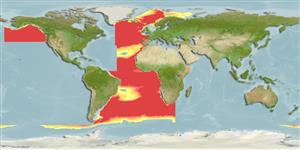Teleostei (teleosts) >
Beryciformes (Sawbellies) >
Melamphaidae (Bigscale fishes or ridgeheads)
Etymology: Poromitra: Greek, poros = porous + Greek, mitra = stripe, belt (Ref. 45335); crassiceps: Named crassiceps for its thick head (Ref. 6885).
More on author: Günther.
Issue
Distribution needs to be defined; previous reports may refer to other species of Poromitra (Ref. 83717, 83719).
Environment: milieu / climate zone / depth range / distribution range
Ecology
Marine; bathypelagic; depth range 164 - 2730 m (Ref. 83717), usually 750 - 2730 m (Ref. 83717). Deep-water
Distribution needs to be defined. Formerly assigned as senior synonym of eight nominal species: P. atlantica, P. coronata, P. cristiceps, P. frontosa, P. nigriceps, P. nigrofulva, P. rugosa, P. unicornis (Ref. 83717).
Length at first maturity / Size / Weight / Age
Maturity: Lm 12.3, range 9 - 15.6 cm
Max length : 14.8 cm SL male/unsexed; (Ref. 54657); max. reported age: 9 years (Ref. 54657)
Short description
Identification keys | Morphology | Morphometrics
Dorsal spines (total): 3; Dorsal soft rays (total): 12 - 13; Anal spines: 1; Anal soft rays: 9 - 10; Vertebrae: 27 - 29. This species is distinguished by the following characters: spinulated (without gap) posterior and lower edges of praeoperculum; insertion of ventral fins behind the vertical of posterior edge of pectoral fin insertion; upper jaw extends beyond the vertical of posterior eye edge; soft rays in dorsal fin 12-13, in anal fin 9-10; rakers at first gill arch 28-30; vertebrae 27-29; pyloric caeca 6 (Ref. 83717).
Oviparous, with planktonic eggs and larvae (Ref. 36655). There is significant morphological variation between populations (Ref. 4241).
Life cycle and mating behavior
Maturity | Reproduction | Spawning | Eggs | Fecundity | Larvae
Kotlyar, A.N., 2008. Revision of the genus Poromitra (Melamphaidae): Part 1. Species of group P. crassiceps. J. Ichthyol. 48(7):479-492. (Ref. 83717)
IUCN Red List Status (Ref. 130435: Version 2024-2)
Threat to humans
Harmless
Human uses
Fisheries: of no interest
Tools
Special reports
Download XML
Internet sources
Estimates based on models
Preferred temperature (Ref.
123201): 1.7 - 6.3, mean 3.2 °C (based on 2535 cells).
Phylogenetic diversity index (Ref.
82804): PD
50 = 0.5000 [Uniqueness, from 0.5 = low to 2.0 = high].
Bayesian length-weight: a=0.00912 (0.00407 - 0.02046), b=3.09 (2.89 - 3.29), in cm total length, based on LWR estimates for this species & (Sub)family-body (Ref.
93245).
Trophic level (Ref.
69278): 3.1 ±0.30 se; based on food items.
Generation time: 10.0 ( na - na) years. Estimated as median ln(3)/K based on 1
growth studies.
Resilience (Ref.
120179): Medium, minimum population doubling time 1.4 - 4.4 years (tmax=8.5).
Fishing Vulnerability (Ref.
59153): High vulnerability (56 of 100).
Nutrients (Ref.
124155): Calcium = 33.9 [12.3, 134.2] mg/100g; Iron = 0.4 [0.1, 1.3] mg/100g; Protein = 2.54 [0.00, 6.45] %; Omega3 = 0.253 [0.068, 0.820] g/100g; Selenium = 8.66 [2.62, 36.13] μg/100g; VitaminA = 89 [11, 829] μg/100g; Zinc = 0.838 [0.424, 1.805] mg/100g (wet weight);
